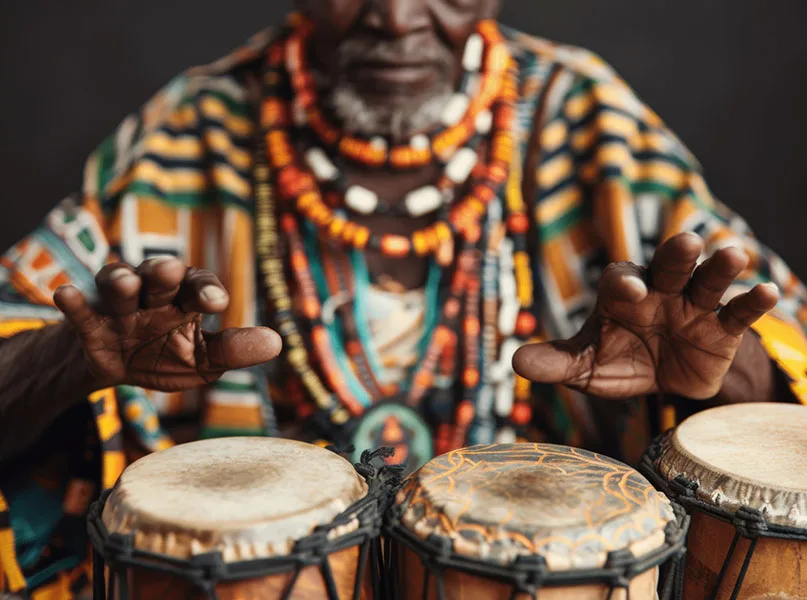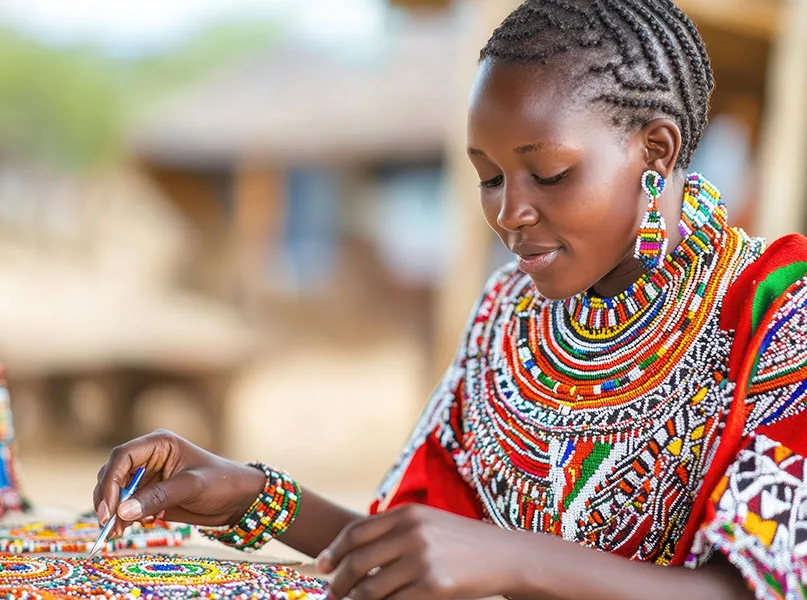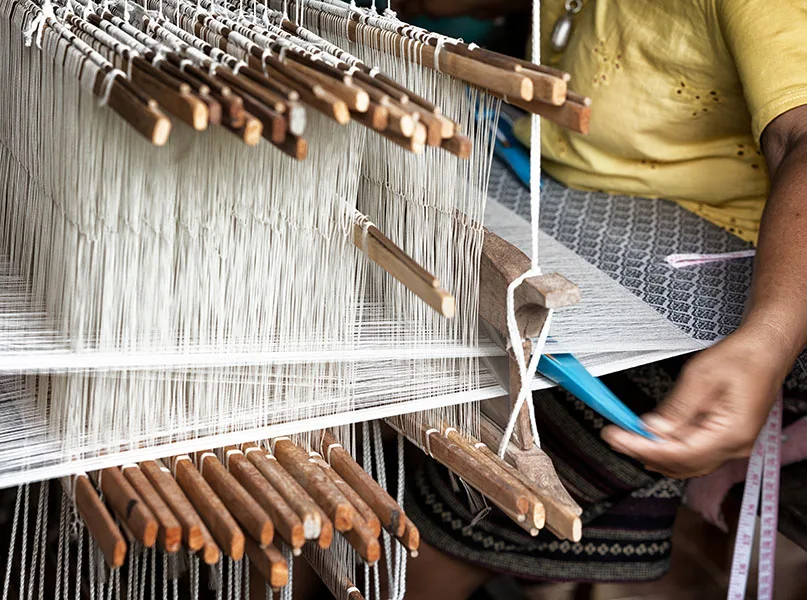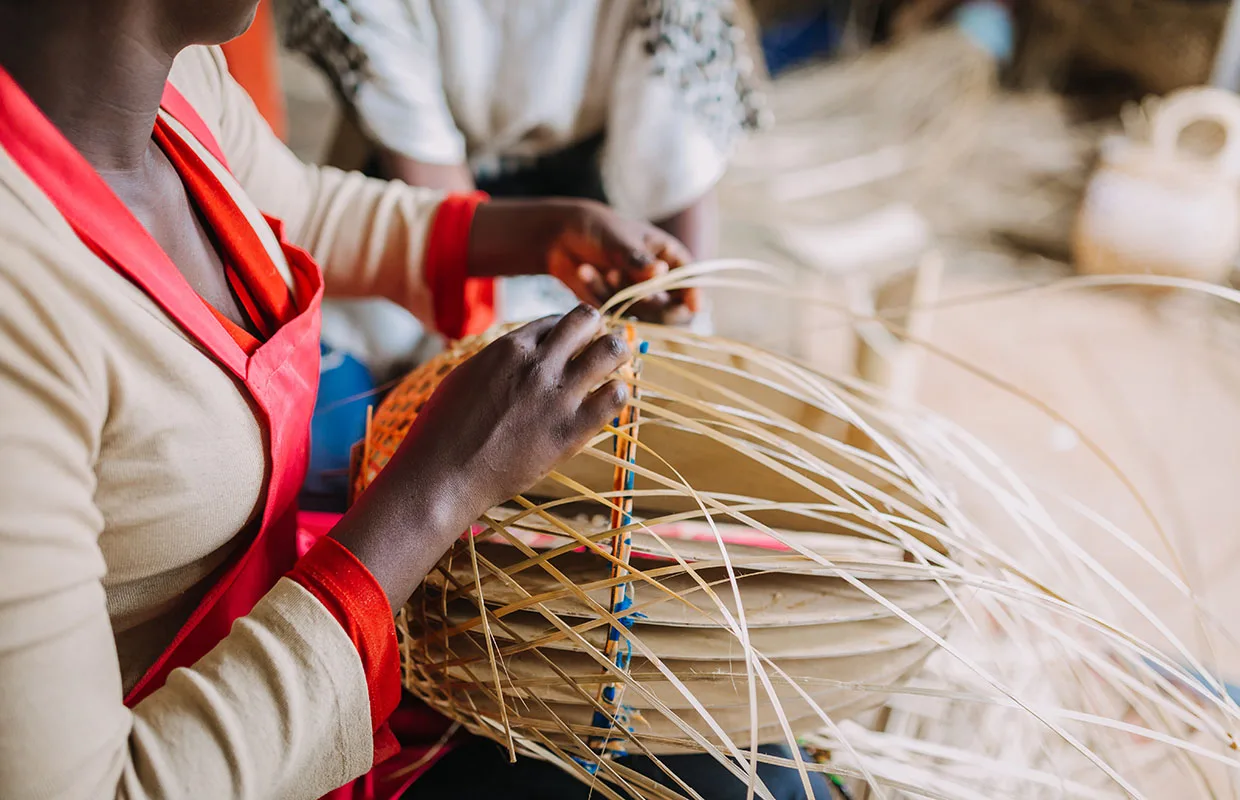The mass-manufactured African souvenir industry and traditional handicraft sector are increasingly converging, as many tourists opt for cheap replicas of the continent’s historic heritage over authentic originals. We illuminate the impact on local communities and how empowerment is key to preserving traditional practices.
CONNECTING CRAFTSMANSHIP WITH A KALEIDOSCOPIC CULTURE
Craftsmanship in Africa spans several millennia, with early civilisations creating tools, pottery, textiles, and jewellery using locally available materials such as clay, wood, metal, and plant fibres.
The arrival of European colonisers in the late 19th century led to a decline in production as industrialisation took hold.
However, in the mid-20th century, a resurgence of traditional crafting methods emerged alongside a rise in independence across the continent. This revival highlighted the importance of national identity symbols, such as colours, patterns, and animal representation, for economic development and cultural pride.
As a result, craft cooperatives and initiatives were established to empower artisans, particularly women. Today, African craft traditions continue to evolve in response to global trends and demands, merging original techniques with contemporary designs to appeal to both local and international markets.
The rise of e-commerce has further expanded their reach, enabling artists to showcase their products to a global audience.
However, the threat of mass-produced imitations poses challenges, with many artisans now focusing on the sustainable and ethical sourcing of their materials alongside adhering to fair trade principles. This approach helps them make positive contributions to their communities.
Souvenirs have always been closely linked to tourism, especially in countries steeped in cultural heritage. In Africa, the industry has rapidly evolved with a shift towards convenience that has encouraged the mass production of items such as colourful Maasai jewellery, masks, and ebony carvings.
However, the introduction of inauthentic travel trinkets means that hand-crafted artefacts, made with skill and precision, are losing their historical significance. In an increasingly globalised world with a booming travel industry, souvenir manufacturing thrives.

TECHNIQUES AND TECHNOLOGIES
Ancient African art is highly valued for its decorative and aesthetic qualities and utilitarian uses; therefore, master craftsmen and women held a special status in society where their skills and expertise were revered.
As an expression of storytelling, these artefacts reflect the rituals and beliefs of various regions and tribes. Different techniques and materials were used, resulting in diverse styles influenced significantly by trade routes and cultural exchanges.
The artistic processes involved in creating cultural crafts require skill as well as an understanding of patterns and symbolism. Intricate techniques such as detailed carving, unique textiles, and complex pottery making have been passed down through generations, often accompanied by rituals and storytelling, further enriching the overall experience.
Preserving these techniques is vital for maintaining cultural identity and continuity within communities, as many African art forms, such as masks and sculptures, are deeply intertwined with spiritual and religious significance.
Vibrant African beadwork has made a global impact on the fashion and tourism industries, featuring a wide range of traditional techniques from stringing and sewing to looms. The integration of technology has enhanced the process by allowing for custom designs with digital tools, whilst online platforms provide a marketplace for artisans to showcase and sell their work to a broader audience.
Each region and tribe in Africa has unique styles, patterns, and meanings associated with beadwork, serving various functions from social status indicators to fulfilling ceremonial roles. For example, the Zulu people of South Africa (SA) are renowned for their geometrical patterns.
Tourism is crucial to the economic impact of beadwork as travellers seek souvenirs. In places like the Masai Mara in Kenya and cultural villages in SA, visitors can witness artisans at work and directly purchase authentic items, enhancing cultural understanding and boosting the local economy.
However, one challenge African beadwork artists face is the prevalence of imitation and mass-produced merchandise.
Cheap, factory-made replicas flood the market, affecting the income of artists, undermining the value and authenticity of handmade items, and diluting the cultural significance of the craft.

ETHICS AND EMPOWERMENT
Supporting local artisans goes beyond mere purchases; it empowers African communities, promotes economic independence, and enables rural-based female entrepreneurs to foster sustainable livelihoods.
Community groups, such as SATUBO, help with skills and training to improve the quality of life for young people and vulnerable members of society.
SATUBO consists of women from the Samburu, Turkana, and Borana tribes in Northern Kenya who face challenges caused by a lack of education, poverty, and limited access to employment opportunities. It was established to empower women and promote sustainable rural development.
In a joint project, SATUBO handcrafted decorations for UK supermarket chain Waitrose, sold as part of Valentine’s Day floral bouquets.
Collaborating with talented groups and individuals not only promotes fair wages but also supports local craftsmanship by prioritising traditional techniques over mass manufacturing, helping preserve cultural heritage. Additionally, the focus on skills development enables artisans to compete effectively in the global market.
To ensure genuinely authentic African products, sourcing materials is rooted in practices that prioritise community impact. Each product is carefully crafted from high-quality, hand-selected materials, including animal skin and horns sourced in accordance with government regulations.
Artisans also utilise upcycled materials, which helps to reduce waste and contributes to a sustainable future. In contrast, mass-produced products overexploit natural resources, leading to environmental damage.
Tourists found in possession of harmful souvenirs, such as coral or botanical samples, have severe penalties imposed on them by local governments.

CULTURE AND CORPORATE COMMODITIES
The history of craft traditions remains an essential component of Africa’s cultural heritage and economic landscape, continuing to adapt and thrive.
Unfortunately, many tourist traps sell items manufactured in bulk from countries outside of Africa and falsely label them as locally made, misleading visitors seeking authenticity.
Factory-produced souvenirs negatively affect artisans’ livelihoods and diminish the storytelling aspect integral to African art and craft. Many tourists unknowingly purchase these cheap replicas, undermining locals who create handcrafted goods.
When tourism revenue is diverted from communities, it can lead to economic instability as authentic artisans struggle to compete in a market flooded with mass-manufactured souvenirs. Additionally, there are environmental concerns regarding the long-term impact on ecosystems and wildlife, especially in regions where natural resources are already under threat.
Exploitation is also a significant issue when companies copy the work of local artisans without providing compensation, primarily due to a lack of legal protection for the unique designs created by these craftspeople.
Decorative masks and colourful jewellery produced in factories often demonstrate cultural appropriation as companies profit from African heritage, symbolism, designs, and techniques without truly understanding or honouring their origins.
Furthermore, cultural appropriation creates economic disparities, particularly when large organisations benefit from the sale of replicas, reducing art to mere trinkets.
Sacrificing quality for cost results in the items lacking durability, causing disappointment for consumers expecting meaningful keepsakes.
There is a growing awareness of the importance of ethical tourism, which encourages travellers to engage directly with artisans and seek handcrafted items from cooperatives in order to support the local economies and help preserve the rich cultural heritage that African art and craft represent.

































